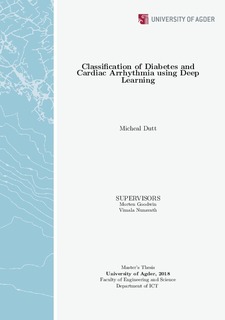| dc.contributor.author | Dutt, Micheal | |
| dc.date.accessioned | 2018-09-19T08:01:14Z | |
| dc.date.available | 2018-09-19T08:01:14Z | |
| dc.date.issued | 2018 | |
| dc.identifier.uri | http://hdl.handle.net/11250/2563353 | |
| dc.description | Master's thesis Information- and communication technology IKT591 - University of Agder 2018 | nb_NO |
| dc.description.abstract | Deep Learning (DL) is a research area that has
ourished signi cantly
in the recent years and has shown remarkable potential for arti cial intelligence
in the eld of medical applications. The reasons for success are the
ability of DL algorithms to model high-level abstractions in the data by
using automatic feature extraction property as well as signi cant amount of
medical data that is available for training these algorithms. DL algorithms
can learn features from a large volume of healthcare data, and then use the
procured insights to assist clinical practice. We have implement DL algorithm
for the classi cation of two diseases in the medical domain: Diabetes
and Cardiac Arrhythmia.
Diabetes is often considered as one of the world's major health problems
according to the World Health Organization. Recent surveys indicate
that there is an increase in the number of diabetic patients resulting in the
increase in serious complications such as heart attacks and deaths. This thesis
presents a Multi-Layer Feed Forward Neural Networks (MLFNN) for the
classi cation of diabetes on publicly available Pima Indian Diabetes (PID)
dataset. A series of experiments are conducted on this dataset with variation
in learning algorithms, activation units, techniques to handle missing
data and their impact on classi cation accuracy have been discussed. Finally,
the results are compared with other machine learning algorithms like
Na ve Bayes, Random Forest, and Logistic Regression. The achieved classi
cation accuracy by MLFNN (82.5%) is the best of all the other classi ers.
The term arrhythmia refers to any variation in the usual sequence of the
heartbeat. There are many types of cardiac arrhythmia ranging in severity,
including Premature Atrial Contractions (PACs), Atrial Fibrillation, and
Premature Ventricular Contractions (PVCs). This thesis focuses on the use
of DL algorithms: Convolutional Neural Network (CNN) and Long Short-
Term Memory (LSTM) to classify arrhythmia with minimum possible data
pre-processing on MIT-BIH Arrhythmia Database (MIT dataset). Furthermore,
we study the in
uence of di erent hyperparameters like L2 regularization
and number of epochs on the classi cation accuracy of LSTM. We
achieved a classi cation accuracy of 99.19% and 98.40% with CNN and
LSTM models respectively. From our research, we believe that CNN model
can assist the doctors in the classi cation of arrhythmia. | nb_NO |
| dc.language.iso | eng | nb_NO |
| dc.publisher | Universitetet i Agder ; University of Agder | nb_NO |
| dc.rights | Attribution-NonCommercial-NoDerivatives 4.0 Internasjonal | * |
| dc.rights.uri | http://creativecommons.org/licenses/by-nc-nd/4.0/deed.no | * |
| dc.subject | IKT591 | nb_NO |
| dc.title | Classification of Diabetes and Cardiac Arrhythmia using Deep Learning | nb_NO |
| dc.type | Master thesis | nb_NO |
| dc.subject.nsi | VDP::Teknologi: 500::Informasjons- og kommunikasjonsteknologi: 550 | nb_NO |
| dc.source.pagenumber | 116 p. | nb_NO |

